You are using an out of date browser. It may not display this or other websites correctly.
You should upgrade or use an alternative browser.
You should upgrade or use an alternative browser.
Nibiru - Planet X - New Age COINTELPRO/Disinformation
- Thread starter durabone
- Start date
Re: Some arguments about "Nibiru" from a NASA astrophysicist
I have a copy of "Nemesis: The Death Star" by Richard Muller that is in my future reading pile. I should have looked at it last night.
I wonder how or why the distance of the object goes from "calculated that it could be as close as 50 billion miles" to "more than 6.5 light-years away". Also one of the two people mentioned above that where looking at the data are mentioned as an author in one of the three papers linked to in the above universetoday.com link.
Also, couldn't find any information on the internet about what this is about "they had found a bright object in the data that matched a 15th-magnitude star photographed at Mount Palomar using the 200-inch Hale telescope."
Thinking about Mount Palomar's mention in the 7 March 2009 session, maybe it was used to find and track Nemesis/Dark Companion. What better place to conduct the search than one that was under control.
Edit Added: And then IRAS was used to confirm the location found from Mount Palomar.
Might be interesting to look into the history of Palomar, but need a subscription or pay $20 for a single article purchase:
THE FIRST 50 YEARS AT PALOMAR: 1949–1999 The Early Years of Stellar Evolution, Cosmology, and High-Energy Astrophysics
_http://arjournals.annualreviews.org/doi/abs/10.1146%2Fannurev.astro.37.1.445
Also, another thing that has always irked me is that when the Hubble telescope went up it wasn't working properly due to a flaw in a mirror. They say it is from a paint speck - how they tracked that one down years later is beyond me. I had thought that Hubble was designed that way so that during the time it was 'broken' it would be used to photograph and map in high resolution the entire earths surface for various military purposes and when I was getting my engineering degree, a person working toward an aeronautical engineering degree had some contact with military engineers asking about a report he was doing on Hubble and they said that that might be right with a smile on their faces. Now my thinking goes along the lines that during the time Hubble was 'broken', maybe it was used to find/reacquire/track the Nemesis/Dark Companion. Just some conjecture.
http://news.bbc.co.uk/2/hi/science/nature/712418.stm
Edit Added: And recently WISE being sent up is used for more tracking and updating of position.
I have a copy of "Nemesis: The Death Star" by Richard Muller that is in my future reading pile. I should have looked at it last night.
I came back to my office one afternoon and was greeted excitedly by Peter Friedman, one of my graduate students. He had taken a message for me from Dave Cudaback. The scientific grapevine had been at work. Dave had heard from Chris McKee about a rumor spread by Martin Cohen at the NASA Ames Research Laboratory. Cohen had heard that two astronomers had found Nemesis.
The astronomers were Frank Low, from the University of Arizona, and Thomas Chester, who worked for the Jet Propulsion Laboratory at the California Institute of Technology. Together they had been studying the data obtained by IRAS, and they had found a bright object in the data that matched a 15th-magnitude star photographed at Mount Palomar using the 200-inch Hale telescope. It had no detectable proper motion and no visible spectral lines. These were characteristics that Nemesis would have if it were a light-mass, "brown dwarf" star, too light for thermonuclear fusion to have ignighted in its core. The team was refusing to give the position of the star until they completed further measurements.
I immediately called Chester. He wasn't in. I left a message asking him to call me back. [...]
Chester finally returned my call. I began, "Hi Tom. I just heard a rumor that someone at Cal Tech has found a candidate for Nemesis. Do you know anything about it?" I could hear Tom chuckling at the other end of the line. "Yes, we are the ones. But don't get excited. Frank Low and I have just completed a week of careful measurements on the star. Just yesterday we were able to show it is not Nemesis. It turned out to be more than 6.5 light-years away. We found spectral lines in the infrared. It is a carbon star." A carbon star is a large red star, made to appear dim only by virtue of its distance.
I wonder how or why the distance of the object goes from "calculated that it could be as close as 50 billion miles" to "more than 6.5 light-years away". Also one of the two people mentioned above that where looking at the data are mentioned as an author in one of the three papers linked to in the above universetoday.com link.
Also, couldn't find any information on the internet about what this is about "they had found a bright object in the data that matched a 15th-magnitude star photographed at Mount Palomar using the 200-inch Hale telescope."
Thinking about Mount Palomar's mention in the 7 March 2009 session, maybe it was used to find and track Nemesis/Dark Companion. What better place to conduct the search than one that was under control.
Edit Added: And then IRAS was used to confirm the location found from Mount Palomar.
Q: (L) I think whatever they were observing or calculating is no longer there, so it's like a defunct machine. (DD) Which leads us to the Palomar observations that they said, with the 4th density occupation beneath the mountain. How long had Palomar been a base before the Rockefellers or the human aspect was added to it?
A: 200 years.
Q: (DD) So 4th density STS had been in the mountain for 200 years before. Were the Rockefeller faction the first humans that were brought into that particular operation?
A: Yes.
Q: (DD) Obviously 4th density STS didn't need an observatory on that mountain. What was their purpose?
A: Of course not, but their minions do. Keeps them in line.
Q: (DD) We went up to the mountain after the Cassiopaean remarks about that - three times. We noticed that there were some very in-plain-site openings beneath the mountain and into the ground. What was the 10-12 foot diameter manhole with a big lid on it. It would take a crane to lift this lid. It looked like you could drop a truck down this hole. What was the purpose of that?
A: Leads to facilities which have another entrance. That entrance is actually an "exit" and opens easily from the inside.
Q: (DD) Okay. We noticed a couple of other smaller, similar manhole structures down there. And we also noticed what looked like a ventilator shaft. I got pretty close to it and listened and it sounded like there was some form of machinery. Was that some sort of life support for the human...
A: Not that. Remember that a large telescopic observatory requires a great deal of technological support, including its own power supply, etc.
Q: (DD) Ah, okay. Is that the purpose of the three buildings on rails that we saw that had the pipes that all came together and ran down the hill or underground?
A: Part of the observation apparatus.
Q: (DD) Okay. Why did 4D STS choose that particular location to build a base?
A: Ah! Now an interesting question! Perhaps you should research the history of the place and factor in the concept of windows between realities.
Might be interesting to look into the history of Palomar, but need a subscription or pay $20 for a single article purchase:
THE FIRST 50 YEARS AT PALOMAR: 1949–1999 The Early Years of Stellar Evolution, Cosmology, and High-Energy Astrophysics
_http://arjournals.annualreviews.org/doi/abs/10.1146%2Fannurev.astro.37.1.445
Also, another thing that has always irked me is that when the Hubble telescope went up it wasn't working properly due to a flaw in a mirror. They say it is from a paint speck - how they tracked that one down years later is beyond me. I had thought that Hubble was designed that way so that during the time it was 'broken' it would be used to photograph and map in high resolution the entire earths surface for various military purposes and when I was getting my engineering degree, a person working toward an aeronautical engineering degree had some contact with military engineers asking about a report he was doing on Hubble and they said that that might be right with a smile on their faces. Now my thinking goes along the lines that during the time Hubble was 'broken', maybe it was used to find/reacquire/track the Nemesis/Dark Companion. Just some conjecture.
http://news.bbc.co.uk/2/hi/science/nature/712418.stm
It transpired that the central region of the mirror was flatter than it should be - by just one-fiftieth of the width of a human hair. This is equivalent to only four wavelengths of visible light, but it was enough. One insider said that the Hubble mirror was "very accurate, very accurately the wrong shape".
Paint speck
What had happened was that many years before, when the mirror was being made, a speck of paint had affected an optical measuring rod. The subsequent measurements were very slightly wrong.
Edit Added: And recently WISE being sent up is used for more tracking and updating of position.
Re: Some arguments about "Nibiru" from a NASA astrophysicist
Check in your e-mail, I happened to have access.
Bear said:Might be interesting to look into the history of Palomar, but need a subscription or pay $20 for a single article purchase:
THE FIRST 50 YEARS AT PALOMAR: 1949–1999 The Early Years of Stellar Evolution, Cosmology, and High-Energy Astrophysics
_http://arjournals.annualreviews.org/doi/abs/10.1146%2Fannurev.astro.37.1.445
Check in your e-mail, I happened to have access.
Re: Some arguments about "Nibiru" from a NASA astrophysicist
Sure, but right now I'm posting from another computer, so I don't have the file in hand. I'll send it tomorrow. If you have another e-mail address, you can send it to me as a PM.
Check in your spam folder just in case too.
Sure, but right now I'm posting from another computer, so I don't have the file in hand. I'll send it tomorrow. If you have another e-mail address, you can send it to me as a PM.
Check in your spam folder just in case too.
Re: Some arguments about "Nibiru" from a NASA astrophysicist
Here is some follow up information/research on the Washington Post article.
Initial study that spawned the Washington Post article:
http://articles.adsabs.harvard.edu//full/1984ApJ...278L..63H/L000063.000.html
Follow up study that individuals point to that no object was sighted:
http://articles.adsabs.harvard.edu/full/1985ApJ...290L...5H
Some ‘official’ debunking of the article and other information:
_http://www.badastronomy.com/bad/misc/planetx/science.html
This archived post, since the original is no longer there, that a few places on the net mention by one of the members of the initial IRAS study, Tom Chester. Tom Chester is also mentioned in one of my posts above.
‘No Tenth Planet Yet From IRAS’
http://archive.is/JGmeV
Another site that has a little information about the controversy.
_http://planet-x.150m.com/iras.html
Here is some follow up information/research on the Washington Post article.
Initial study that spawned the Washington Post article:
http://articles.adsabs.harvard.edu//full/1984ApJ...278L..63H/L000063.000.html
Follow up study that individuals point to that no object was sighted:
http://articles.adsabs.harvard.edu/full/1985ApJ...290L...5H
Some ‘official’ debunking of the article and other information:
_http://www.badastronomy.com/bad/misc/planetx/science.html
This archived post, since the original is no longer there, that a few places on the net mention by one of the members of the initial IRAS study, Tom Chester. Tom Chester is also mentioned in one of my posts above.
‘No Tenth Planet Yet From IRAS’
http://archive.is/JGmeV
Another site that has a little information about the controversy.
_http://planet-x.150m.com/iras.html
JulieSunshine
A Disturbance in the Force
Re: Some arguments about "Nibiru" from a NASA astrophysicist
Thank you for addressing this topic. I've been going crazy wondering what is the truth. It's starting to be a whole lot easier and my nightmares ( and DAYmares ) are gone Daddy gone! Thankee!


Thank you for addressing this topic. I've been going crazy wondering what is the truth. It's starting to be a whole lot easier and my nightmares ( and DAYmares ) are gone Daddy gone! Thankee!



1984
The Living Force
Re: Some arguments about "Nibiru" from a NASA astrophysicist
Welcome to the Forum, JulieSunshine. We encourage new members to post an intro in our Newbie section. No need for personal details, just a bit about how you found us, what your interests are, etc.JulieSunshine said:Thank you for addressing this topic. I've been going crazy wondering what is the truth. It's starting to be a whole lot easier and my nightmares ( and DAYmares ) are gone Daddy gone! Thankee!


Cat
The Force is Strong With This One
Google Sky Reveals Nibiru Youtube Submission June 24, 2015
Google Sky has just uncovered an area in space that was previously censored, or hidden, showing us what appears to be Planet X, also known as Nibiru—and according to in-depth studies, it is allegedly headed toward earth! NASA has clearly been lying to us—More on this below! Could they be lying to us about other events that people have been sounding the alarm about? The answer is YES! But first…
_http://worldtruth.tv/nasa-has-just-been-caught-in-a-huge-lie-and-we-are-in-serious-trouble/
https://www.youtube.com/watch?t=484&v=pxUUQfWJzfY
Google Sky has just uncovered an area in space that was previously censored, or hidden, showing us what appears to be Planet X, also known as Nibiru—and according to in-depth studies, it is allegedly headed toward earth! NASA has clearly been lying to us—More on this below! Could they be lying to us about other events that people have been sounding the alarm about? The answer is YES! But first…
_http://worldtruth.tv/nasa-has-just-been-caught-in-a-huge-lie-and-we-are-in-serious-trouble/
https://www.youtube.com/watch?t=484&v=pxUUQfWJzfY
Re: Google Sky Reveals Nibiru Youtube Submission June 24, 2015
Hi Cat, first of all, welcome to the forum! I gope you take some time to introduce yourself on the Newbies section. :)
Regarding the links you posted, I've had a look at them along with other related material on the web (e.g. the claim that an asteroid or comet will hit earth in September this year), and so far I haven't found much of substance. Instead there is much rumour and hearsay ("a source that wishes to remain anonymous") and biblical apocalyptic interpretations.
There are also some news items more or less taken out of context. For example, a Forbes article is quoted regarding billionaire's bunkers. But nowhere in that article does it say that they are retreating to their bunkers in panic. In fact, it's mostly a series of pictures of these bunkers, many of which do not seem to be designed to survive a nuclear war or comet strike.
One claim is that Planet X has been spotted on Google Sky, because apparently an area of the sky was missing an image and now Google has posted it. But I don't see why any of the objects on that image should be taken to be Planet X. The "in-depth studies", as they put it, that would indicate that this Planet X object is heading to earth, seem to be no other but Zacharia Sitchin's books. But the vague way it's phrased makes it sound as if a group of scholars has come up with a scientific analysis confiming that the object in the Google image is indeed heading our way.
One red flag with these stories is that they are being promoted by the website Before It's News, which is notorious for publishing disinformation.
This does not mean that there are no catastrophic scenarios awaiting us some time in the future (in fact, some catastrophes are already happening, like floods, earthquakes, storms, etc), but at this point I don't think there is any valid reason to expect a 2.5 mile wide comet to hit the Atlantic at the end of September 2015.
Hi Cat, first of all, welcome to the forum! I gope you take some time to introduce yourself on the Newbies section. :)
Regarding the links you posted, I've had a look at them along with other related material on the web (e.g. the claim that an asteroid or comet will hit earth in September this year), and so far I haven't found much of substance. Instead there is much rumour and hearsay ("a source that wishes to remain anonymous") and biblical apocalyptic interpretations.
There are also some news items more or less taken out of context. For example, a Forbes article is quoted regarding billionaire's bunkers. But nowhere in that article does it say that they are retreating to their bunkers in panic. In fact, it's mostly a series of pictures of these bunkers, many of which do not seem to be designed to survive a nuclear war or comet strike.
One claim is that Planet X has been spotted on Google Sky, because apparently an area of the sky was missing an image and now Google has posted it. But I don't see why any of the objects on that image should be taken to be Planet X. The "in-depth studies", as they put it, that would indicate that this Planet X object is heading to earth, seem to be no other but Zacharia Sitchin's books. But the vague way it's phrased makes it sound as if a group of scholars has come up with a scientific analysis confiming that the object in the Google image is indeed heading our way.
One red flag with these stories is that they are being promoted by the website Before It's News, which is notorious for publishing disinformation.
This does not mean that there are no catastrophic scenarios awaiting us some time in the future (in fact, some catastrophes are already happening, like floods, earthquakes, storms, etc), but at this point I don't think there is any valid reason to expect a 2.5 mile wide comet to hit the Atlantic at the end of September 2015.
Cat
The Force is Strong With This One
Re: Google Sky Reveals Nibiru Youtube Submission June 24, 2015
Maybe I should have made my thoughts known at the time of the posting. I appreciate, that anyone who has read Laura's work, one must validate, that what is 'out' there usually has some truth mixed in with garbage. I wanted to show, what is being said but mostly, that there is 'something of value' being reported in picture format of this winged planet and that it had been skewed from visibility; to now be revealed.
After this reveal, I've checked online for any news feed on Google, and there is nothing. It is quiet out there. It does beg questions.... doesn't it?
Maybe I should have made my thoughts known at the time of the posting. I appreciate, that anyone who has read Laura's work, one must validate, that what is 'out' there usually has some truth mixed in with garbage. I wanted to show, what is being said but mostly, that there is 'something of value' being reported in picture format of this winged planet and that it had been skewed from visibility; to now be revealed.
After this reveal, I've checked online for any news feed on Google, and there is nothing. It is quiet out there. It does beg questions.... doesn't it?
Attachments
stellar
The Living Force
Re: Google Sky Reveals Nibiru Youtube Submission June 24, 2015
Just on the topic of planet x, I have recently watched a few YT videos/interviews with a man named Gill Broussard. I found his research into facts of previous cataclysmic events and related historical/astronomical records to be really interesting.
There is one where he is interviewed by a lady calling herself J7409, and a rather longer one on episode 305 on Caravan to Midnight. There seems to be something to it and may be worth a listen. Even though he has a lot of biblical references it still seems to fit into his timing context and interpretation of various events.
FWIW :/
Just on the topic of planet x, I have recently watched a few YT videos/interviews with a man named Gill Broussard. I found his research into facts of previous cataclysmic events and related historical/astronomical records to be really interesting.
There is one where he is interviewed by a lady calling herself J7409, and a rather longer one on episode 305 on Caravan to Midnight. There seems to be something to it and may be worth a listen. Even though he has a lot of biblical references it still seems to fit into his timing context and interpretation of various events.
FWIW :/
Re: Some arguments about "Nibiru" from a NASA astrophysicist
Have a look but not necessary to watch the whole thing which is mainly a sales job. Skip to the parts about the two videos:
The Sanibel video showed the moon in the sky with the sun and object. I had to check the moon phases and set my Starry Night program to the location and run it through a few days to find the date and time: 22 Sept 2015 at about 5:59 PM. So, I checked around in the sky on that day and time and here's what I saw:
At about the moment the Sanibel video was taken, Jupiter was on the horizon. Venus and Mars had just dropped below. Mercury was above and to the left of the Sun which is actually SW of the Sun not "North" as the observer says though I think she just meant "above" when she said "North." So, Mercury was actually pretty much in the position of the alleged Nibiru. Though, of course, we know that Mercury never looks like that UNLESS there is a pronounced lensing effect. That's what I think was happening here. Though it wasn't Mercury that was being "miraged" but the sun itself.
As I have been repeatedly telling people, our atmosphere has changed significantly due to a number of factors including changes in the cosmic environment which affect the Sun, Earth and all other planets in the solar system.
The Cs described all of these things 20 years ago and they are all happening exactly as described. The Nibiru nonsense was begun as a way to divert attention, create confusion, disinform, etc. As Victor Clube said: "We do not need the celestial threat to disguise Cold War intentions; rather we need the Cold War to disguise celestial intentions!" It's not just the cold war that is distracting people from what is happening, it is all the disinfo being propagated about Earth Changes. There is going to be a LOT more weirdness before it is over and, indeed, the ancients saw and described stuff, it just wasn't "Nibiru" as the disinfo of Sitchin as propagated.
Have a look but not necessary to watch the whole thing which is mainly a sales job. Skip to the parts about the two videos:
The Sanibel video showed the moon in the sky with the sun and object. I had to check the moon phases and set my Starry Night program to the location and run it through a few days to find the date and time: 22 Sept 2015 at about 5:59 PM. So, I checked around in the sky on that day and time and here's what I saw:
At about the moment the Sanibel video was taken, Jupiter was on the horizon. Venus and Mars had just dropped below. Mercury was above and to the left of the Sun which is actually SW of the Sun not "North" as the observer says though I think she just meant "above" when she said "North." So, Mercury was actually pretty much in the position of the alleged Nibiru. Though, of course, we know that Mercury never looks like that UNLESS there is a pronounced lensing effect. That's what I think was happening here. Though it wasn't Mercury that was being "miraged" but the sun itself.
As I have been repeatedly telling people, our atmosphere has changed significantly due to a number of factors including changes in the cosmic environment which affect the Sun, Earth and all other planets in the solar system.
The Cs described all of these things 20 years ago and they are all happening exactly as described. The Nibiru nonsense was begun as a way to divert attention, create confusion, disinform, etc. As Victor Clube said: "We do not need the celestial threat to disguise Cold War intentions; rather we need the Cold War to disguise celestial intentions!" It's not just the cold war that is distracting people from what is happening, it is all the disinfo being propagated about Earth Changes. There is going to be a LOT more weirdness before it is over and, indeed, the ancients saw and described stuff, it just wasn't "Nibiru" as the disinfo of Sitchin as propagated.
Some examples of atmospheric lensing/refraction. Note that this can include sky mirages which have occurred a number of times in recent years giving credibility to the idea that the Earth's atmosphere has changed significantly.
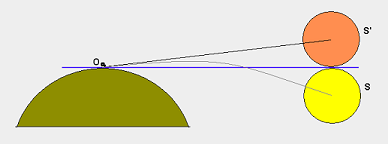
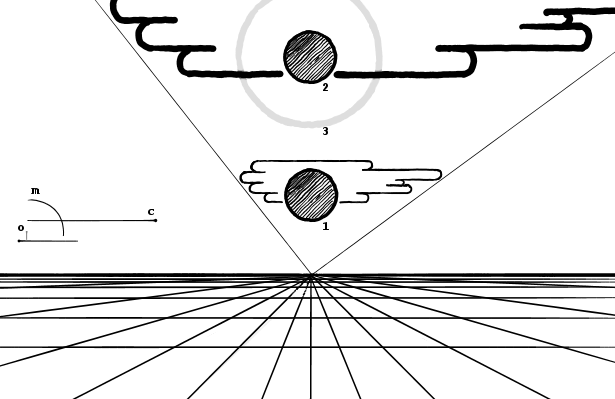
The Moon illusion - illustration of the apparent distance hypothesis (i.e. a cloud of a certain size at a certain height in the atmosphere subtends a smaller angle if it's lower towards the horizon than if it's more nearly overhead; since the moon subtends basically the same angle whether it's overhead or near the horizon, therefore it's perceived as larger near the horizon.
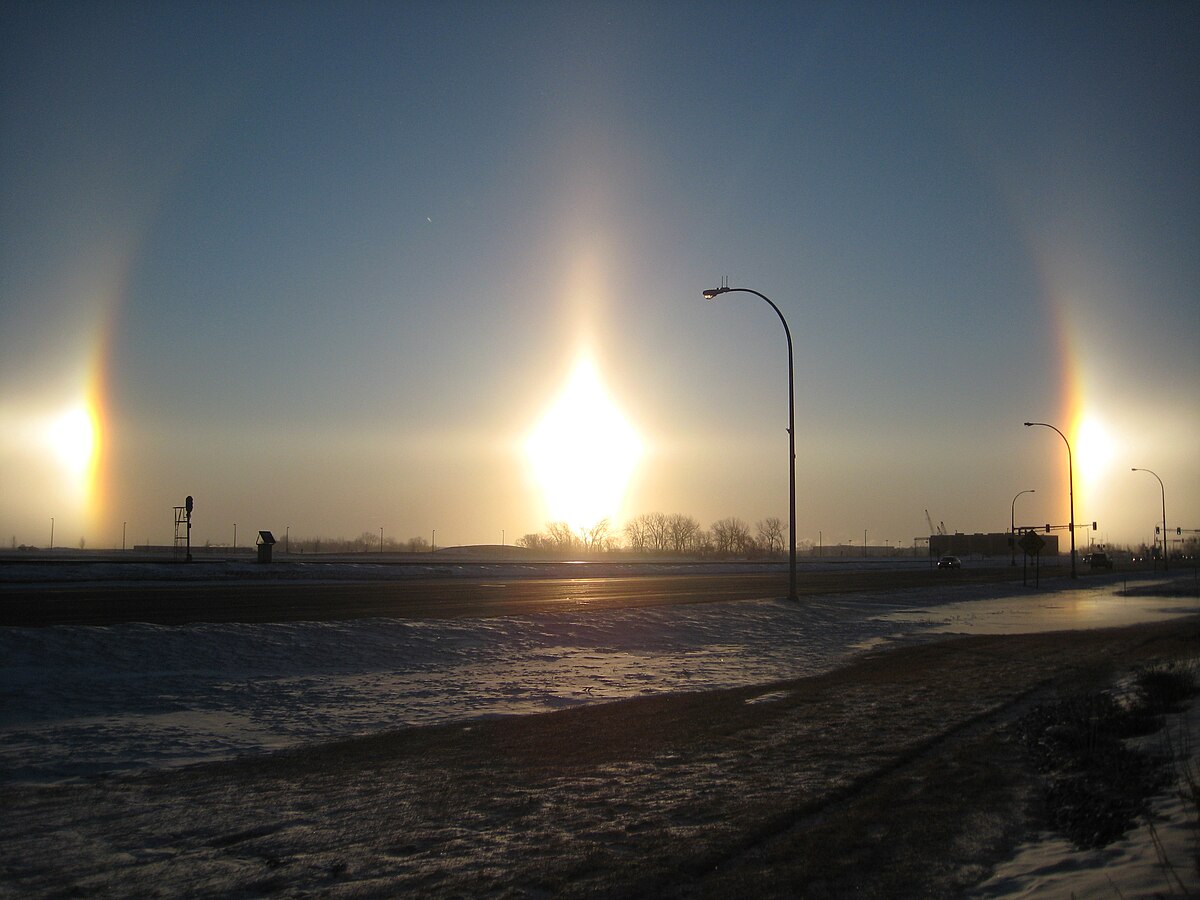




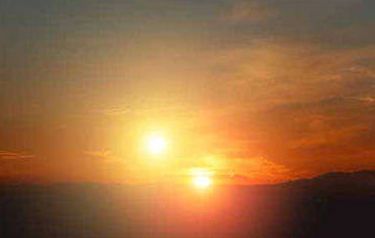
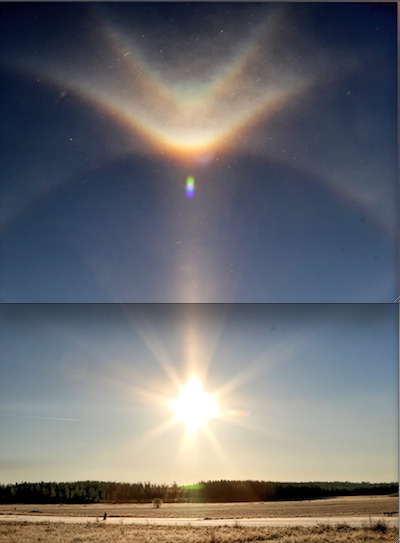
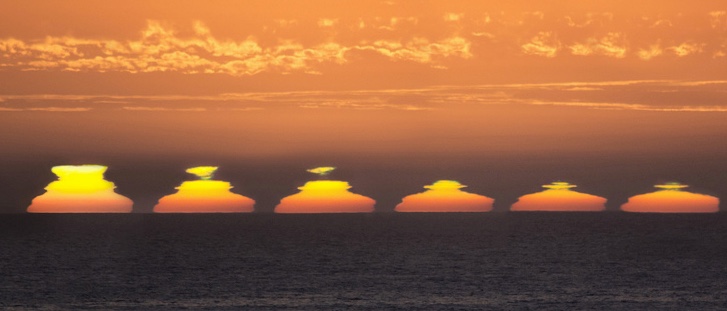
Notice in the above images that there are a couple of them that exhibit the exact same refraction effect as the Sanibel and CA videos... double image above and to the left.


The Moon illusion - illustration of the apparent distance hypothesis (i.e. a cloud of a certain size at a certain height in the atmosphere subtends a smaller angle if it's lower towards the horizon than if it's more nearly overhead; since the moon subtends basically the same angle whether it's overhead or near the horizon, therefore it's perceived as larger near the horizon.







Notice in the above images that there are a couple of them that exhibit the exact same refraction effect as the Sanibel and CA videos... double image above and to the left.
Trending content
-
-
Thread 'Coronavirus Pandemic: Apocalypse Now! Or exaggerated scare story?'
- wanderingthomas
Replies: 30K -
-

